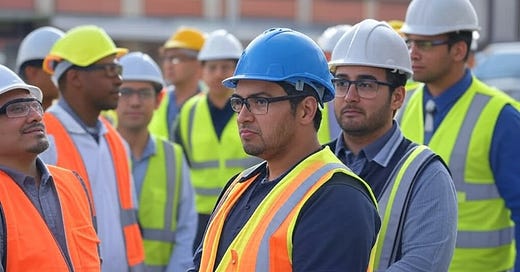Navigating Labor Strategies in Commercial Services Businesses
The 4 Strategies to use to grow and development your human capital and how to apply each of them to your business.
In the dynamic world of commercial mechanical contracting, managing your workforce effectively isn't just about finding skilled workers; it's about strategic planning that aligns with your business's growth and project demands. Here’s how you can apply the "Build, Bridge, Borrow, Buy" strategy to your labor management:
Build: Cultivating Your Own Talent
Why It Matters: In mechanical contracting, the complexity of projects often requires highly specialized skills. Building your workforce from within can ensure a team that's not only skilled but also deeply integrated into your company's culture and standards.
Apprenticeships and Training Programs: Start by establishing an apprenticeship program. This not only addresses the industry's skill shortage but also allows you to mold individuals according to your company’s best practices. Offer ongoing training for existing employees to keep their skills sharp and up-to-date with the latest industry trends and technologies.
Career Development Paths: Create clear career ladders for your employees. Show them the path from apprentice to journeyman to project manager. This not only aids in retention but also ensures you have a pipeline of leadership ready to take on bigger roles.
Culture of Learning: Foster an environment where learning is continuous. This could mean investing in certifications, safety training, or even soft skills development for better project management and client interaction.
Bridge: Managing Transition and Growth
Why It Matters: As your business grows, you'll face periods of transition where you need to scale up or down quickly or bridge gaps in knowledge or expertise.
Interim Roles: Use temporary positions to manage peaks in workload or to cover for employees on long-term leave. This can also be a way to test potential full-time hires before making a long-term commitment.
Mentorship Programs: Pair seasoned workers with newcomers or those moving into new roles. This not only transfers knowledge but also helps in maintaining project quality during transitions.
Project-specific Leadership: For large projects, consider bringing in interim project managers or specialists who can bridge the gap until your team can handle it internally.
Borrow: Leveraging External Resources
Why It Matters: Mechanical contracting often involves projects that are too specialized, short-term, or outside your core competencies to justify permanent hires.
Subcontracting: For specialized tasks like certain types of welding, plumbing systems, or HVAC installations beyond your team's current expertise, subcontracting can be invaluable. Choose partners whose skills complement your own.
Freelancers and Consultants: Engage freelancers for short-term needs, like CAD designers for a particular project or consultants for safety audits. This provides flexibility without long-term overhead.
Temporary Staffing Agencies: For labor-intensive phases of projects, temporary workers can help manage workflow without the commitment of permanent staff.
Buy: Strategic Hiring
Why It Matters: Sometimes, the fastest way to meet urgent needs or to leapfrog into new markets or technologies is by hiring from outside.
Headhunting: For key positions like project managers, lead engineers, or business development roles where experience and networks are crucial, a targeted recruitment strategy can bring in individuals who can make an immediate impact.
Acquisitions: If you're looking to expand rapidly, consider acquiring smaller contractors. This brings not just labor but also potentially new client bases, equipment, and established project methodologies.
Recruitment Campaigns: For filling roles that are critical to your business strategy, a well-executed recruitment campaign can attract top talent from competitors or other industries.
Conclusion:
Incorporating the "Build, Bridge, Borrow, Buy" strategy into your labor management practices can significantly enhance your Commercial Firm’s resilience, adaptability, and growth potential. By understanding when and how to use each strategy, you ensure your workforce is always aligned with your business objectives, capable of handling the diverse and often unpredictable demands of the industry. Remember, the key is balance - knowing when to invest in your team's growth, when to borrow expertise, when to bridge gaps, and when strategic hiring or acquisitions are necessary. This multifaceted approach will keep your company competitive and ready for any project that comes its way.
Professionally, I work primarily with commercial services company’s to identify and achieve their organizational goals, then prepare for if/how those goals will affect their human capital (aka their people).
If you want to learn more, you can reach me at dan@frontporchadvisers.com or send me a DM via Sub stack
If you want to chat about your thoughts on this topic, please send me an email dan@frontporchadvisers.com or drop me a message using the button below. Would love to meet for coffee, a beer, or a virtual conversation.
Have a good one,
Dan





